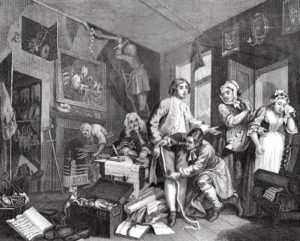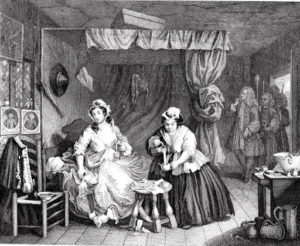Something in the English character is fundamentally literary. No other culture can claim so many great poets, playwrights, and novelists. So pronounced is this tendency that it even surfaces in the visual arts, not least of all in the work of William Hogarth, whose satirical prints read like scenes in a play, or chapters in a novel.

A scene from Hogarth’s “The Rake’s Progress.”
Rich with amusing incident and realistic detail, Hogarth’s etchings and engravings confronted the sordidness of 18th century English daily life, and drew moral lessons about the consequences of folly and vice. They carried titles such as “The Rake’s Progress” or “Marriage A-la-Mode,” and the audience was the same one that was gobbling up the novels of Daniel Defoe and Henry Fielding.
These and other prints can be seen at the Miriam and Ira D. Wallach Art Gallery on the campus of Columbia University. The show, organized by the British Museum and the Berkeley Art Museum, celebrates the 300th anniversary of the artist’s birth, and shows him to have been a controversial and contradictory figure, with a variety of personae – witty satirist, stern moralist, libertine, aggressive self-promoter, detached observer, and man of the people. It also puts his career in perspective, by showing the works of predecessors, contemporaries, and followers.
Born in London in 1697, Hogarth was self-taught, serving as an apprentice to a silver engraver before moving on to a career as a successful portrait painter in the 1720s. In the early 1730s, he began his first satirical narrative cycles, such as “A Harlot’s Progress,” which traces the gradual seduction of a naive country girl into a life of decadence and prostitution, and “A Rake’s Progress,” in which the son of a wealthy landowner squanders his inheritance on wine, women, and gambling, before winding up in debtor’s prison and, finally, the madhouse.
Hogarth aimed his barbs at all levels of English society. He was particularly hard on people who sought to move out of their social class by any means other than hard work and virtue. Both the Harlot and the Rake repudiate their natural class, and come to ruin.

A scene from “Harlot’s Progress.”
In the first plate from “A Harlot’s Progress,” we see an innocent country girl disembarking from a stage in London, and being met by the madam of a brothel, while a notorious seducer lurks in the background. Interestingly, both of these villains are representations of real people, recognizable to the audience of the time. In subsequent prints, the girl is transformed into the mistress of a merchant, a high-priced prostitute, and, finally, a streetwalker.
The Rake, the son of a merchant, attempts to rise above his true station in life by adopting the ways of an aristocrat. He commits various cruelties, such as abandoning his pregnant fiance. In the most famous image, we see him at the height of his debauchery, drunk and disheveled, his arms around two disreputable women.
Although he clearly preferred revealing people’s follies, Hogarth also could cast his moral lessons in a positive direction. In the series “Industry and Idleness,” a young apprentice works his way up to a respectable position through hard work, while his idle counterpart tumbles into the criminal underworld.
One of the contradictions in Hogarth’s art was that he could be moralistic, preaching that vice is loathsome, while at the same time exploiting its visual appeal. In a pair of prints called “Before” and “After,” for example, he tries to show the sordidness of a seduction, but, in the process, arouses prurient interest.
Hogarth was not a modest man. His self-portrait of 1749 shows him confident, with strong features and a frank, penetrating gaze. The picture-within-a-picture format has his portrait resting on volumes of Shakespeare, Milton, and Swift – suggesting the tradition to which he believed he belonged.
But is popularity and the satirical nature of his work caused him to worry that he wouldn’t be taken seriously. He took pains, in a print of multiple heads, to demonstrate the difference between portraits that revealed a person’s “character,” and those that were “caricatures.” In 1753, he published “The Analysis of Beauty,” an illustrated tract on visual form in which he emphasized the importance of the elegantly curving rococo line.
Although he had a respectable place in 18th century London, Hogarth was fearless in ridiculing important people, even entire professions, as in “The Company of Undertakers,” in which some of the most celebrated physicians of the day are shown as pompous grotesques and lethal quacks. In “The Sleeping Congregation,” the flock dozes as a minister drones on.
Prints such as these made enemies, and Hogarth’s last years were marked by attacks from artistic and political foes. He was even satirized by other satirists.
His very last print, “The Bathos,” is a heartbreaking and cynical image, a scene of ruin, death, and decay, in which the artist depicts the end of his life as the end of the world.

